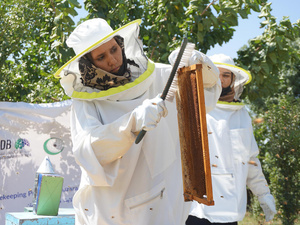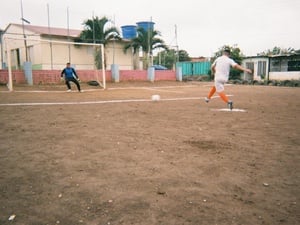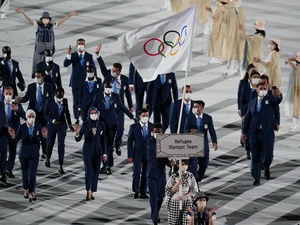Designers on a mission: dressing refugee girls for sports
Designers on a mission: dressing refugee girls for sports

Somali refugee girls in their new sports uniforms, with the Nike design team in Dadaab camp, Kenya.
DADAAB, Kenya, July 6 (UNHCR) - There is a fan hanging from the ceiling in the stitching room of Ifo camp, one of the three refugee camps in Dadaab, eastern Kenya, but at this time of the day it barely has an impact. It is hot this afternoon - really hot. But the Somali women, fully dressed in their traditional hijabs (veils), don't seem to be bothered by the heat. They're concentrating on stitching red and bright pink sports uniforms.
It's a different story for Ellen Tavenier, Quality Engineer for the Kids Department at Nike's European headquarters. She has been feeling the heat in the stitching room for some hours now. Having a professional eye for detail, she is not happy with a hood made by one of her "students", who normally makes sanitary towels that require only simple cutting and straight stitching.
"It needs to be curved better," says Tavenier. "Otherwise it doesn't fit well around the face and it will bother you when you play volleyball." She explains the pattern patiently, because when she leaves, the refugees will have to be able to make the uniforms themselves.
Tavenier was one of the many employees from Nike's EMEA (Europe, Middle East and Africa) Apparel organisation who raised their hands when volunteers were needed to meet the challenge to design culturally sensitive, comfortable clothing that refugee women could wear while playing sports in the camps.
The design process required a lot of research and creative thinking. Tight shirts or shorts - basically anything that shows the shape of the body - were out of the question. The design had to be comfortable to play volleyball in over 40°C heat, and the material sturdy enough to survive the harsh conditions.
"Selecting volunteers for this project was hard. We had many candidates," says Annie Francis, Senior Manager of Corporate Responsibility for Nike EMEA. "But in the end, these particular women all had the experience we needed for this project. And they are team players," she adds, referring to Tavenier and three other colleagues.
Indeed, there is no space for prima donnas in the desert. Working is hard in a refugee camp, and living here is extremely tough. "Imagine living here for 15 years without knowing if or when you can go home," says Emmanuel Nyabera, UNHCR's spokesman in Kenya.
The UN refugee agency started establishing camps in Kenya in 1991 and 1992 when thousands of people crossed the border to escape from the violence in Somalia. Now almost 130,000 refugees live in Ifo, Dagahaley and Hagadera camps, some 500 km from Kenya's capital Nairobi. The refugees depend on UNHCR and CARE, which implement projects for almost everything from food to water, sanitation and education.
UNHCR and Nike started the "Together for Girls" project last year. It combined UNHCR's expertise in assisting refugees with Nike's experience in inspiring excluded young people through sports and physical activity, in this case as a tool to increase the number of girls going to school.
"Playing sports gives our girls a break from their daily life," explains Adar Osman Horar, one of the leaders in the camp. As a female leader, she is an exception in this male-dominated environment, where girls have to drop out of school and community activities to look after the household.
"Sport builds their self-esteem," she adds. "If they take part in sports activities linked to the schools, more girls will also continue to go to school. That's why the 'Together for Girls' project is so important for us. It is important to know that companies such as Nike haven't forgotten about us."
Finally, at the end of Nike's four-day mission, the six members of a refugee volleyball team step into the crowded community service building, looking a bit uncertain. All eyes, including those of the imams and the leaders of the clans in the camps, are on their colourful outfits. But when applause bursts out, a big smile appears on their faces.
It's a relief for the Nike design team as well. "This is what we worked so hard on for the last days and weeks," says Senior Mac Art worker Marit Kleine, watching the volleyball team play their first match in their new gear.
The "Together for Girls" partnership is just warming up. In the first year of the project, additional teachers were hired and trained, sports and youth personnel were hired, new classrooms were built, girl-friendly latrines were constructed and learning materials including books, pencils and paper were distributed. More recently, Nike has been supporting interventions in infrastructure and human resources needed to make girls' education activities in Dadaab's refugee camps possible.

Nike's Gulsun Erkal teaching the girls to sew their outfits.
Nike has committed itself until 2007 to "Together for Girls", with the idea to bring other partners to the table. It will invest significantly in the partnership, comprising part product, part cash.
The company is also one of the founding members of UNHCR's Council of Business Leaders launched in January this year at the World Economic Forum in Davos in the presence of UNHCR Goodwill Ambassador Angelina Jolie. The Council advises UNHCR on its strategies to best catalyse innovative public-private partnerships, and help the agency find new sources of private-sector funding. The Council consists of top executives from five companies that are working with UNHCR to improve opportunities for refugees: Merck, Microsoft, Nestlé, Nike and PricewaterhouseCoopers.
By Hans Faber
Nike Europe, Middle East and Africa









